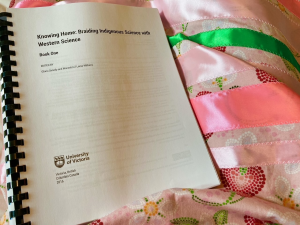18 Knowing Home: Braiding Indigenous Science with Western Science
Dakota Reid and Kaysha Tickner
Contributors’s Biographies:
Dakota Reid is a fourth-year student at Kwantlen Polytechnic University and wishes to teach High School participants in the future. To do this, they are gaining a major in Geography and a minor in Counselling Psychology. Dakota is passionate about education and creating equal learning opportunities for all students; this resource will help do just that!
Kaysha Tickner is working towards becoming an Elementary school teacher and looks forward to integrating Indigenous Knowledges in their future classroom.
Resource Overview
Pressbook:
Snively, E. G., & Williams, W. L. (2016). Knowing home: Braiding Indigenous science with Western science: Book 1. The University of Victoria. https://pressbooks.bccampus.ca/knowinghome/
Grade Level: Grades five to twelve
Description:
The resource assists educators in gaining a more comprehensive understanding of Indigenous science and how educators can intertwine these teachings and knowledge systems into the Western science curriculum relating to our Earth, home, and land. This book exemplifies important Ways of Knowing that reach beyond the Westernized approach. With this resource, educators can easily incorporate the following forms of Indigenous education: 1. Traditional Ecological Knowledge (TEK), 2. Indigenous Knowledge (IK), 3. Indigenous Science (IS). The book Knowing Home discusses intent by stating that:
“since Indigenous Peoples have developed time-proven approaches to sustaining both community and environment, Elders and young people are concerned that this rich legacy of Indigenous Science with its wealth of environmental knowledge and the wisdom of previous generations could disappear if it is not respected, studied, and understood by today’s children and youth” (Snively & Williams, 2016, p. xiv).
The book is a reminder that many people living in Canada are settlers, meaning people who have immigrated and settled on land that they reside on.
Significant Indigenous Knowledge:
The resource predominantly takes an Indigenous Science Approach and framework. Snively & Williams demonstrate Indigenous Ways of Knowing by discussing Indigenous children’s ideas, beliefs, and worldviews. The resource’s approach to learning is significant for all participants and extends beyond those with Indigenous culture, status, or ancestry. The authors reiterate that “this book refers to the science knowledge of all peoples who, as participants in culture, are affected by the worldview and interests of their home communities and homelands” (Snively & Williams, p. 80, 2016). One of the significant differences between Westernized views and Indigenous views is the teaching strategies. Within Indigenous science frameworks, the term “coming to know” is used. An important question to consider is how do we come to know things, and how do we pass down the things we know to others? Indigenous teachings and learnings revolve around lifelong journeys “towards wisdom” (Snively & Williams, 2016, p. 80).
Necessary Prior Knowledge:
Before using this resource, it is recommended that the educator becomes familiar with Indigenous perspectives. It is imperative for reconciliation that educators move away from Eurocentric views of teaching and learns how to incorporate multiple perspectives, as “[r]esearch shows that a majority of participants prefer to understand nature through other worldviews” (Snively & Williams, 2016, p. 2). Educators must understand the importance of different views and the benefits these various teachings bring to classrooms. Knowing Home is not stating Westernized teaching is wrong. However, it acknowledges that Indigenous perspectives are just as valuable. The book suggests Westernized, and Indigenous science should coexist or be taught alongside each other. The parallel of teaching both cultural science views will enhance one another.
Suggested Learning Activities

Image by: Rachel Chong BY-NC-ND (Attribution Non-Commercial No Derivatives)
References
Snively, E. G., & Williams, W. L. (2016). Knowing home: Braiding Indigenous science with Western science: Book 1. The University of Victoria. https://pressbooks.bccampus.ca/knowinghome/

